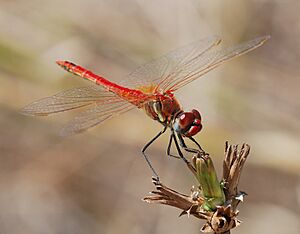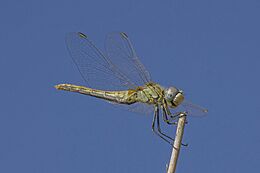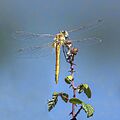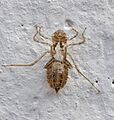Red-veined darter facts for kids
Quick facts for kids Red-veined darter |
|
|---|---|
 |
|
| Male | |
|
|
|
| Female | |
| Conservation status | |
| Scientific classification | |
| Synonyms | |
|
Sympetrum fonscolombei Selys, 1840 |
The red-veined darter or nomad (Sympetrum fonscolombii) is a type of dragonfly. These amazing insects are known for their bright colors and how they fly. They belong to a group of dragonflies called Sympetrum, which are often called "darters."
Contents
About the Red-Veined Darter's Name
The scientific name for this dragonfly is Sympetrum fonscolombii. It was named by a Belgian scientist, Edmond de Sélys Longchamps, in 1840. He chose the name fonscolombii to honor a French scientist named Étienne of Fonscolombe. Sometimes you might see its name spelled a little differently, but fonscolombii is the correct way.
Where Red-Veined Darters Live
The red-veined darter is a very common dragonfly found in many parts of the world. You can see them across central and southern Europe, including many islands in the Mediterranean Sea. They also live in North Africa, the Middle East, and parts of Asia, like India and Sri Lanka.
These dragonflies are special because they are "nomads." This means they can travel long distances. In warmer southern areas, they live there all year. But in some years, they fly north to places like Belgium, Sweden, Finland, Poland, Britain, and Ireland. They are even the only type of darter found on the Azores islands.
Red-Veined Darter Habitats
Red-veined darters like to live near water. They can be found in many different watery places, such as marshes, lakes, and ponds. They also live near rivers that flow all year or even rivers that only appear after rain. They are good at finding new places to live, even in dry areas after a good rainfall.
How to Identify a Red-Veined Darter
Red-veined darters are medium-sized dragonflies, usually about 38 to 40 millimeters long. They look similar to other darter species, but if you get a good look, especially at a male, you can usually tell them apart.
Male Red-Veined Darters
Male red-veined darters have a bright red body, especially their abdomen (the long tail part). This red is often brighter than other darter species. Their face and chest area are reddish-brown. Their eyes are brown on top and blue-grey underneath. The veins in their wings are red, and the base of their back wings has a yellow color. They also have a pale yellow spot on their wings called a pterostigma, which has black lines around it.
Female Red-Veined Darters
Female red-veined darters look similar to males but are not red. Their abdomen is a yellowish-brown color, and they have two black lines running down each side. The veins at the front and base of their wings are yellow, not red like the males. Both male and female red-veined darters have legs that are mostly black with some yellow parts.
Young Red-Veined Darters
Young male red-veined darters look more like females. They are often yellowish-brown but might have more red on their bodies. They usually have a single black line along each side of their abdomen.
Similar Dragonflies
Sometimes, male red-veined darters can be confused with another very red dragonfly called Crocothemis erythraea. However, Crocothemis erythraea has no black on its legs, a wider body, and no black on its head. With a little practice, you can easily tell these two species apart!
Red-Veined Darter Life and Behavior
Red-veined darters can be seen flying almost all year long in warmer areas, especially around the Mediterranean Sea. However, they are most active from May to October. They are less common during the winter months.
Behavior
Male red-veined darters are known to be territorial. This means they will often sit on a high spot, like a plant stem, and watch over their area. They will chase away other male dragonflies that come too close.
Reproduction and Life Cycle
When a male and female red-veined darter mate, they often stay connected while the female lays her eggs. You can see pairs flying together over open water, with the female dipping her abdomen into the water to drop her eggs. Sometimes, they even fly over the sea and dip into saltwater, but the eggs laid there usually don't survive.
A cool fact about red-veined darters is that they grow up very quickly. Their eggs and larvae (young dragonflies that live in water) develop in just a few months. Unlike most other European dragonflies, red-veined darters can have more than one generation born in a single year! Some of their larvae might even stay in the water over the winter.











